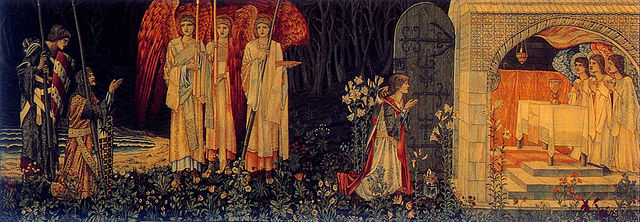The Fisher King is a figure in Arthurian legend, the last in a long line of British kings tasked with guarding the Holy Grail. The Fisher King is both the protector and physical embodiment of his lands, but a wound renders him impotent and his kingdom barren. Unable to walk or ride a horse, he is sometimes depicted as spending his time fishing while he awaits a "chosen one" who can heal him. Versions of the story vary widely, but the Fisher King is typically depicted as being wounded in the groin, legs, or thigh. The healing of these wounds always depends upon the completion of a hero-knight's task.
Perceval arrives at the Grail Castle to be greeted by the Fisher King in an illustration for a 1330 manuscript of Perceval, the Story of the Grail.
The bloodied head on a plate in T. W. Rolleston's Myths and Legends of the Celtic Race (1910) "Peredur had been shown these things to incite him to avenge the wrong, and to prove his fitness for the task."
Sir Balin stabs Pellam in the "Dolorous Stroke" in Lancelot Speed's illustration for James Knowles' The Legends of King Arthur and His Knights (1912) "The castle rocked and rove throughout, and all the walls fell crashed and breaking to the earth."
The Holy Grail is a treasure that serves as an important motif in Arthurian literature. Various traditions describe the Holy Grail as a cup, dish, or stone with miraculous healing powers, sometimes providing eternal youth or sustenance in infinite abundance, often guarded in the custody of the Fisher King and located in the hidden Grail castle. By analogy, any elusive object or goal of great significance may be perceived as a "holy grail" by those seeking such.
The Damsel of the Sanct Grael by Dante Gabriel Rossetti (1874)
Galahad, Bors and Percival achieve the Grail. Tapestry woven by Morris & Co. (19th century)
Sir Galahad, the Quest for the Holy Grail by Arthur Hughes (1870)
The Holy Grail depicted on a stained glass window at Quimper Cathedral







